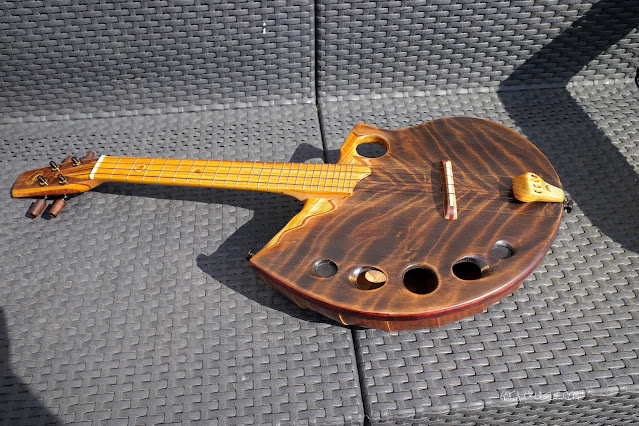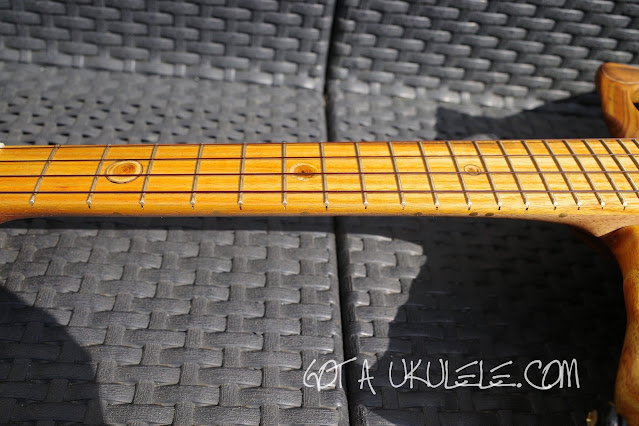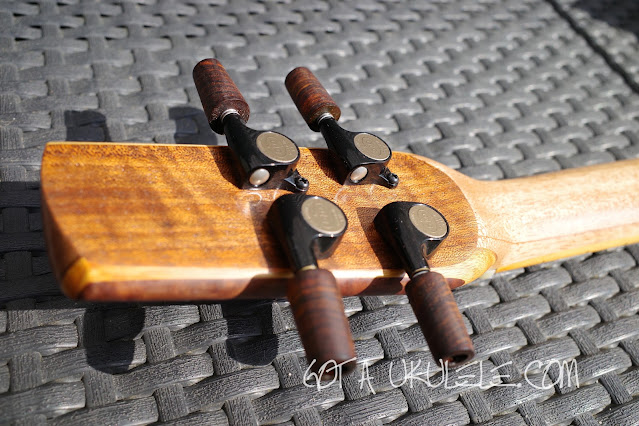One of the joys of writing the Got A Ukulele website is being able to spend time with such a wide range of instruments. And add on top of that, instruments that are just extraordinary. Step right up Ray Vincent and one of his tenor ukuleles..
Pause.. just pause.. have a look.. pause again.
Help! And bear with me, this could be a long one..
I have NO idea how to review this as it is so completely different to anything I have seen before! From the moment Ray, a musician and luthier from Ontario Canada first got in touch with me, I've struggled to get the images of these ukes out of my mind. Then it arrived, in plenty of time for this review. When that happens I usually put the box on the shelf to allow to me to focus on the reviews I should actually be dealing with first, but this one has made me keep opening the case, having a peek, having a play, putting it away... then opening the case again.. I don't think i've ever started a review in that way before, but honestly.. just pause again and look at it.
SUMMARY VIDEO REVIEW
As I say Ray is an instrument maker (not just ukes) based in Ontario and hand builds instruments that, it's fair to say, look like no others i've ever reviewed before and taking his inspiration from nature. And as you can probably tell if you first browsed the images, due to that wildly different look, my usual checklist for uke reviews is out of the window! One basic I can deal with at this point is that this is a tenor ukulele and that it is, quite clearly, based on a nautilus shell / golden ratio / Fibonacci spiral. Beyond that we are in uncharted Got A Ukulele waters!
The top is made from solid curly redwood in two very nicely book-matched pieces. The stripe looks wonderful and I adore how the wood has been tapered down at the top edges to reveal paler wood in different shades in a kind of wave. That is just beautiful. And there is more 'shell' referencing on the top with a series of holes which I think are aiming for an Abalone / Paua shell look with their pores. Down the left hand side there are five of which the middle three are actual sound holes and the other two are decorative. Ray explains he experimented with them all being sound holes, but with five it was affecting the sound negatively. On the opposite side is a thinner part of the top that you will see closes the gap of the 'back shell' and also has a hole in it that you can see right through. The whole thing is utterly remarkable and I can't stop looking at it.
The back is highly unusual too and where the nautilus shell look comes in. This is created with various pieces of laminate koa, bent into shape and overlaid in a fan arrangement to create the shell look. This is an old building technique used in boats which is both extremely strong, but also very light. As I say above the section of the top that isn't covering the back shell is extended to create an area onto which the neck is fitted. What's also interesting here is that whilst the real estate on the top is large, because the 'shell' doesn't cover the whole of the back, when held it doesn't feel like such a large thing after all. At the centre of the spiral is a lovely circular wood detail piece that finishes it off made from a slice of a pine branch. Oh, and that hatch is (I presume!) to get at the pickup wiring that is inside - more detail on that below.
The bridge is a floating bridge style as used on jazz box guitars made from a sandwich of contrasting woods. Into that is set a bone saddle and being a floating bridge, that has string notches placed in it to separate the strings which then run down to a carved tail piece made of Canary wood for tying off. This arrangement suits the look of the instrument perfectly I think. String spacing at the saddle is 41mm.
It seems odd to say there isn't any decoration, but what I mean by that is that there is no binding or sound hole rosettes to speak about that usually come in at this point in my reviews. But come on... how would you even do that. WHY would you even do that? The decoration here IS the instrument itself. The finish is done with Osmo oil which gives it an ultra smooth, yet organic feel rather than a slippy mirror gloss. It feels like a fine piece of furniture. I use the word 'tactile' in a number of my reviews of nicely made instruments. This is off the scale in that regard!
The neck is made of mahogany and is carved with a 12 inch top radius. That's bolted into the body with an unusual arrangement that includes a Canary wood and Koa cover plate. I'm also not sure how the jointing at the headstock works, but it kind of naturally transforms into more Canary and Koa at that end. The first thing the neck reminded me of was the feel of an electric guitar neck - very smooth, slick and comfortable. It's shallow profile all the way along with rolled edges for even more comfort. At the nut I measure it at 38mm across and 29mm G to A.
Topping that is more Canary wood for the fingerboard. It's fitted with 24 Evo Gold frets (a superb high end fret material) joined at the body at the 18th. That's very unusual when you consider this is still a 17 inch scale tenor. It gives it the feel of a much larger instrument (and I'm not just talking about the body) with a lot of room to play. Almost like a tenor guitar feel. The frets are polished and dressed as good as any I have any I have ever seen on an instrument as I think some followers will have seen on the sneak peek pictures I shared earlier in the week. They really are outstanding. The position markers are in somewhat unusual positions at the 3rd, 7th and 12th. I say 'unusual', yet these are positions often used on ukuleles, but the lack of a marker at the 5th and 10th at first threw me is all! But it's all about aesthetics as you get those dots added in on the side in small brass inlays! The outward dots are circular cross sections of pine branches like on the back of the body, only much smaller. What a neat idea! They look great!
Beyond the bone nut is an extremely attractive headstock. Whilst the shape is not unusual per se, the detailing is sublime. I looks to be a compound of koa and canary and the angled shaping shows off those grain matches on the sides in a wonderful way. At the nut end is what looks like a cover for the end of the truss rod (or perhaps it's just decoration). At the top is an inlaid cross section of a pine cone set in clear resin. I have never seen anything quite like that before and just adds yet another lay of the 'organic' to this instrument. So pretty.
The tuners the excellent Gotoh 510 mini gears in black. To add more style here Ray has removed the usual tulip shaped buttons and added hand carved round cocobolo buttons. Something else i've seen nothing of the like before and gives it an almost historic / baroque look. Ray explains that he is fully aware that for those people who like to use peg winders, these will be problematic so he provides the original tuner buttons in the case if you want to swap back!
Finishing things off are a set of Worth Brown strings (in low G), an active Mi-si Trio saddle pickup (about as good as pickups get for ukuleles, and the only active system i'd ever recommend) and a, frankly staggering, hand made custom wooden case with an 'extras' box for your bits and pieces made from a re-purposed cigar box. The case alone is a wonderful thing with subtle dot inlays referencing the 'spiral' of the body.
When Ray first got in touch to ask me to take a look the one thing I didn't know was the price. In fact waiting for this to arrive I was pondering what that would be because there is a considerable amount of work in this. I was therefore highly surprised to see that the UK price for this is £2,000. Of course that is a lot of money, but just look at these pictures again. This is not a mere ukulele, this is a piece of art and significant craftsmanship. Heck I reviewed an aNueNue Singer ukulele which, whilst beautiful is positively 'plain' compared to this, and that was £1700... I was extremely and pleasantly surprised at that price though I guess value means different things to different people and two grand isn't an impulse price!
So that was a lot to get through, but honestly I could have written whole paragraphs swooning over the smallest details here as everywhere I look there is wonderful and clever craftsmanship. It would therefore be a crying shame if it didn't play very well...
A lot of people will be asking how it is to hold and this is quite surprising too. Despite the size and shape whilst it's heavier than regular tenor this is not really not too bad at 945g. And whilst it comes with strap buttons I find I can easily play it standing without one. As I say above, that back shape actually makes it feel smaller than it is. Played seated and it's a breeze too. Not what I was expecting at all. Setup is great, and of course with a floating bridge you can fiddle with optimum saddle placement to your hearts content, but action wise it's absolutely bang on. And I love, love, LOVE the feel of the neck.
The volume here is absolutely terrific, no doubt helped by the construction style, but it really barks. Sustain is good, not stellar, but a little more staccato particularly on strums (less so on picking which chimes). And that slight staccato edge made me realise what the tone sounded like - rather like a resonator ukulele without the metallic edge that a reso cone can give you.
It's been really hard to pin down for me on tone. It doesn't sound like a regular ukulele, and whilst I make that resonator comparison, it doesn't fully sound like one of those either. I suspect that large top and floating bridge is giving it that 'drum head' kind of sound, but of all the ukuleles I have ever reviewed it has a sound all of its own.
The tone is warm and has a woody edge (though I suspect would brighten up with a re-entrant G, which I think I would personally prefer) and has excellent clarity. When strummed the staccato edge gives it much more of a rhythmical, bouncy sound which is spritely and enjoyable, much as you will get when strumming a resonator. What surprised me is how it turns into a different beast when fingerpicked as it has a really pleasant chimey tone to the notes that hold their volume right up the neck and tend to display more sustain too. And of course, if you play both together in chord melody style, a strum here, a picked fill there, you get a bit of both worlds. For me I think it suits melody and picking more than strumming, but I can see how the strummed tone would appeal to a more jazzy / ragtime type tune. I suspect I will get some comments from people who don't think the tone is for them (which is cool) but remember - this is not a Kamaka Tenor with the usual overtones of a trad built double bout instrument. Just like the looks, the sound here is 'different' too. Well, it had to be! Personally, I dig it!
(And yes, I plugged it in, but not going to do so on the video. It's a Mi-Si - it sounds great and a faithful reproduction of the acoustic tone but louder! One thing you should note is there is less of that drum head sound plugged in and more of the core uke.)
This has been a tough one to review on account of how different it is, but also probably the review I've enjoyed the most in all my years doing this. It's been a joy. It also makes it very hard to score, but you will see it has done VERY well. I totally get that when you build something quite so different that I am sure I will have people comment saying the look is not for them - and they are absolutely at liberty to do so, I just happen to think it's a beauty. Looks are a very subjective thing. And all my scores are in some way subjective as I am always conscious that 'there may be something better around the corner'. As such I rarely use 10 out of 10 for anything. In this case though, whether you like the looks or not, there is no way this could score less than 10 on fit and finish. Not only is this made wonderfully, it's using high level skills and craftsmanship at every turn and to do that down would be an insult. I've said above that it's a piece of art as much as it is an instrument. Thankfully it's therefore also incredibly pleasing that it plays well and sounds great too if a little different to a regular uke (though that is no bad thing). It's a statement ukulele for sure that would make a big impact for the right performer, and it's been an utter joy to look at.
Quite simply - Astonishing work..
(Oh, and one more thing - you MUST visit his website - it's like looking at an art book!)
https://rayvincent.ca/
https://rayvincent.ca/
UKULELE SPECS ROUNDUP
Model: Ray Vincent Tenor
Body: Solid Curly Redwood top, laminate koa shell back
Bridge: Unspecified woods, floating style
Saddle: Bone
Spacing at saddle: 41mm
Finish: Osmo oil
Neck: Mahogany with graphite truss rod
Fingerboard: Canary wood with 12" radius
Frets: 24 Evo Gold frets (18 to body)
Nut: Bone
Nut width: 38mm, 29mm G to A
Tuners: Gotoh 510 mini tuners
Extras: Mi-Si trio under saddle pickup, custom handmade case
Weight: 945g
Country of origin: Canada
Price: £2,000
UKULELE PROS
Amazing concept and design
Serious skill and craftsmanship in the construction
Not heavy and easy to hold
Wonderful neck
Great volume
Excellent pickup
Excellent pickup
A warm clear tone all of its own - slightly reso, slightly uke, slightly drum head, slightly.. I don't know what!
That case!
More than fair price for the craftsmanship
UKULELE CONS
You are joking right?
UKULELE SCORES
Looks - 9.5 out of 10
Fit and finish - 10 out of 10
Sound - 9 out of 10
Value for money - 9 out of 10
OVERALL UKULELE SCORE - 9.4 out of 10
SUMMARY VIDEO REVIEW
GOT A UKULELE IS NOT PAID BY BRANDS OR SHOPS - YOUR KIND DONATIONS ARE WHAT KEEP THE SITE GOING! THANKS FOR YOUR HELP!
SAY THANKS WITH A BEER!
BECOME A GOT A UKULELE PATREON
OR THRU PAYPAL
THANKS!













Wow. I'd put VfM at 10 as well. I guessed it would cost £5000 because it is a piece of art not simply the finest craftsmanship. I'll bet it is sold by the end of the week.
ReplyDelete